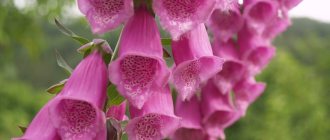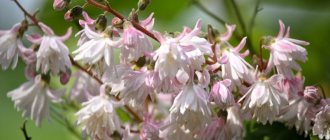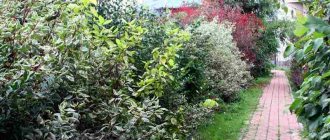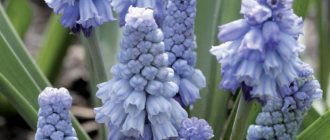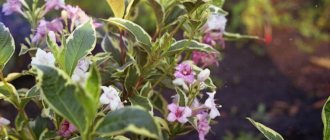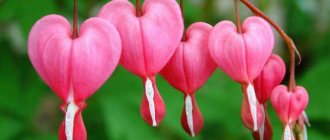Types and varieties of Armeria
There are more than 10 varieties of armeria, widely used for garden decoration, but for central Russia they are best suited:
| View | Description | Leaves | Flowers |
| Alpine | A perennial shrub that forms dense cushions up to 0.3 m long. The stem is up to 150 mm. | Linear-lanceolate. | Pale pink, size – up to 30 mm. Inflorescences are capitate. |
| Beautiful (pseudoarmeria) | Grows up to 0.4 m. Flowering duration is from June to August. | Dark green. | White and pink. |
| Primorskaya (gorgeous) | Homeland - European countries located on the seashores. Grows up to 20 cm. | Narrow, linear shape. Color – blue-green. | Mauve. Inflorescences are capitate. |
| Soddy (juniper-leaved) | Distributed in the mountains of southern Europe. Perennial shrub, reaches a height of 150 mm. | Linear type, form a rosette up to 20 cm in size. | Red or pink. |
| Velvich | Tall, trunk – 35 cm. | Large, about 100 mm long, 50 mm wide. | The inflorescences have a capitate shape. Color – pink. The size of the buds is up to 20 mm. |
| Ordinary (garden) | Grows up to 0.6 m. | Whole edges, linear shape. Length – about 125 mm, width – 10 mm. | Carmine pink. Up to 40 buds on one peduncle. |
| Beautiful | It has a straight trunk, 20-25 cm high. | Narrow-linear, evergreen. | White, red or pinkish. The size of the buds is about 50 mm. |
| Siberian | Homeland - mountainous regions of Siberia and Mongolia. Low-growing shrub - up to 20 cm. | Elongated, light green. | Small, purple. |
| Arctic | Frost-resistant biennial. Flowering duration is 2 months. | Narrow, linear. | Single, spherical, pale pink. |
| Zunderman | It is considered a mixture of seaside and turf varieties. Perennial, trunk - about 18 cm. | Length – about 150 mm. Dark green. | Lilac. |
| broadleaf | Decorative, has lush root vegetation. | Linear. | Small ones. The color of the buds is white or light pink. Inflorescences are spherical in shape. |
| Bulbous | Tall, reaching 0.5 m. Flowering duration - from late spring to June. | Narrow. Light green. | Purple. |
| Prickly | Homeland: Portugal and Spain. Consists of a large number of sockets. | Bluish. | Medium size, pink. Inflorescences are loose. |
Some of the presented varieties of Armeria became the founders of a number of original varieties.
Alpine Armeria
| Variety | Description | Flowers |
| Alba | Perennial, stem – up to 150 mm. | White. |
| Laucheana | It has linear-lanceolate foliage. Low growing, up to 150 mm. | Carmine red. |
| Rosea | Perennial, stem 12-15 cm. | Rich pink. Inflorescences are capitate. |
Beautiful Armeria
| Variety | Description | Flowers |
| Joystick White | Grows up to 0.4 m. Occasionally cultivated as an annual. | White. The inflorescences are spherical in shape. |
| Thrift | It is one of the low-growing species, the trunk is up to 20 cm. | Pink. |
| Red Planet | Perennial. Peduncles about 30 cm. | Red, spherical. |
| Bees Ruby | Stem up to 0.6 m. | Hot pink. |

Maritime armeria and its varieties: Louisiana and others
| Variety | Description | Flowers |
| Louisiana | It has blue-green linear leaves. Trunk – up to 20 cm. | Pale purple. |
| Dusseldorf Stolz | Narrow foliage. Erect stem reaching 18-20 cm. | Burgundy. |
| Vindictive | The foliage is flat. Color – green-blue. Flowering duration is from May to mid-August. | Reds. |
| Bloodstone | The size of the root rosette is up to 0.2 m. Height is up to 20 cm. The leaf plate is flat, the color is blue-green. | Small, bloody. Inflorescences are capitate type. |
Soddy Armeria
| Variety | Description | Flowers |
| Brno | Low-growing, the stem reaches 150 mm. Terry type. | Color – lilac. |
| Bevan's Variety | The dimensions of the root rosette are about 20 cm. The shrub is 150 mm. The foliage is narrow, linear. | Light pink. |

Description and characteristics of Armeria seaside
Seaside Armeria (Armeria maritima), also Magnificent Armeria, is a perennial herbaceous plant that forms the genus of the same name in the Svinchataceae family. The leaves are simple in shape, narrow, lanceolate. The surface is smooth or pubescent. Collected in a basal rosette, they form cushions with a diameter of up to 25 cm, reaching a height of 15 cm. The mounds are of a beautiful soft green color; they are used as ground covers.
The stems of Armeria seaside are straight, reaching a height of no more than 30 cm. The inflorescences are spherical heads of pink or red color, sometimes snow-white. The sizes vary - from 1.5 to 3 cm. The flowers are symmetrical, radial in shape, and give a very pleasant aroma. Flowering lasts from May to June (period of 60–70 days), although there are also late varieties. The fruits are dry capsules, producing one egg-shaped seed, their size is 2x1 mm. The root system is taprooted and shallow, so you need to loosen the soil shallowly.
Armeria maritime is distributed throughout Eurasia and North America. It is found in temperate and arctic climate zones, mainly near sea coasts, which is how it got its name. In culture, growing varieties of Primorsky Armeria is possible in most Russian regions - from the middle zone and the North-West to Siberia and the Far East.
Planting and propagation methods
There are a number of methods for planting and breeding armeria:
- grown from seeds;
- apply seedlings;
- divide the bush.

Planting seeds in the ground
To germinate the maximum number of seeds, 7 days before sowing, they are transported to the refrigerator. And 7-9 hours before planting in the ground, place it in warm water mixed with Zircon or another growth stimulant.
The optimal time for planting in open ground is the end of November or the beginning of spring. When grown in greenhouse conditions, the seeds are used in the last days of February.
When using this planting material, it is buried 1-2 cm. Dry soil is sprinkled on top, the layer thickness is 5 mm.

Seedling method
Using the seedling method, the seeds are prepared in the same way as when planted in open ground.
Then perform the following manipulations:
- soil suitable for the flower is poured into small containers;
- seeds are buried 2 cm;
- containers are placed in a warm and well-lit room and await germination. After the seedlings form 2 true leaves, they are planted in different containers;
- sowing in open ground is done in the spring, but even careful preparation of the seeds does not guarantee their complete germination;
- grown and strengthened plants are moved into the garden immediately after the threat of frost has passed. Select an area with soil saturated with sand and stones. The ideal place is an alpine slide next to a pond.
Armeria should not be planted in alkaline soil. Flowers planted in this soil become sick and lose their decorative properties. Calcareous soil is neutralized by adding an vinegar solution.
Vegetative propagation
Every year, shrubs form a large number of basal shoots. The turf, dense in its structure, is divided into 2-3 parts and planted in various corners of the garden. The first procedure is performed when the armeria reaches 3 years of age.
Produced at the end of August, immediately after the end of the flowering period. Each plot must have a strong rhizome. The interval between new plants is about 20 cm.
In summer, the flower is propagated by cuttings. To do this, a young rosette that does not have a root system is separated from the turf. The shoot is moved to loose and well-drained soil and covered with a cap for 7-14 days. Ventilate every day and water as needed.
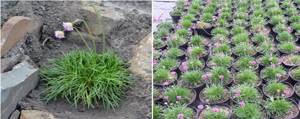
Preparing Armeria seeds for sowing: mandatory stratification
In general, we can say that the germination rate of Armeria seeds is very good. However, for successful germination, planting material needs pre-sowing preparation, namely stratification.
Stratification of Armeria seeds is a mandatory procedure for preparing seed material for planting as seedlings. This procedure will help to obtain faster and more friendly shoots. During stratification, the seeds are kept in cold and damp conditions (at a temperature of 2-4 degrees Celsius), the ideal place at home is the refrigerator.
Optimal stratification period: two weeks. However, the procedure is allowed within 7 days (at least!).
After stratification, just before sowing, it is recommended to soak the seeds in ordinary warm water (6 hours) or in a growth stimulator , for example, Zircon (follow the procedure according to the instructions).
By the way! Armeria seeds can also be sent for stratification after planting in containers (the procedure diagram will be described below). Just don’t forget to treat the seeds first by soaking them in plain water or a growth stimulant!
Armeria care
During growth, armeria requires virtually no care. But before the buds appear, they must be fertilized with complex mineral products. In the future, manipulations are repeated every 14 days.
During the rainy season, the crop does not require additional moisture. In dry weather, water the plant twice a week, but do not allow water to stagnate.

At the age of 5 years, the flower is replanted and the bush is divided. In the future, the procedure is performed every 3 years.
To increase the duration of flowering, prune dried stems in a timely manner. If the planting site is correctly chosen, the armeria practically does not get sick, but if a fungus is detected, then complete pruning is carried out.
Growing and caring for armeria
Among gardeners, Armeria is considered a fairly unpretentious perennial, but there are still some subtleties in caring for a beautifully flowering plant. Particular attention should be paid to the acid-base balance of the substrate and the irrigation regime.
Location, soil
Under natural conditions, the flower usually grows in meadows, so try to find a warm, bright area for the armeria, but protected from direct sunlight. The eastern or southern side of the garden is best suited for planting. In too dark places, the plant simply stops blooming, and its foliage becomes more faded. An exception to this rule is turfy armeria; it must be reliably protected from ultraviolet radiation.
The soil should be moderately moist and slightly acidified. If necessary, spill the soil with ammonium nitrate or acetic acid solution. Surprisingly, Armeria feels great in sandy and rocky soil. The main condition for the soil is good drainage. The flower does not tolerate stagnation of moisture at the roots very well. Therefore, in swampy gardens, armeria is planted on a hill or in a raised bed. If you have chosen overseas armeria for your garden, try to find a moist place for it, preferably next to a pond.
Watering, fertilizing
The first month after planting, armeria is watered quite often. In the future, it will require much less water: an adult plant has enough moisture that it receives from precipitation. Therefore, watering is carried out only in hot weather, exclusively as the soil dries out. It is preferable to do this in the evening.
[!] After each watering, do not forget to loosen the soil to prevent moisture from stagnating at the roots.
Shortly before flowering, armeria is fertilized with any mineral complex. And in order for the plant to have enough strength to form buds throughout the summer, the armeria is given additional feeding approximately once every 2-3 weeks.

Trimming and shaping
In order to improve the decorative properties of armeria, it is necessary to regularly cut off the drooping flower stalks with pruning shears, without waiting for them to dry out. This will not only make the plant tidier, but will also allow new ovaries to develop faster.
Care after flowering, collecting seeds
Typically, fading inflorescences are tied with gauze, and after a couple of days they are cut and dried. After this, you can collect the seeds, separating them from the dust. But this method is usually resorted to only when there is a need to share seed material with someone. In other cases, you don’t have to do this: armeria reproduces well by self-sowing.
The collected seeds are usually planted immediately before winter, but if desired, they can be stored in a dry, dark place. They will remain viable for about 2-3 years.
Wintering
Wild armeria can be found even in Eastern Siberia - it is a cold-resistant flower that does not require any special conditions for wintering. It will be enough to simply cut off the dried flower stalks and throw more snow on the flowerbed.
[!] The only exception is the soddy armeria, which cannot tolerate cold weather. It overwinters in much the same way as roses: the bushes are covered with peat, spruce branches or greenhouse film.
Certain precautions will be required in regions where there are frequent temperature changes and thaws occur every winter. In such conditions, the plant may become covered with an ice crust or simply dry out. To avoid this, cover the armeria with the same spruce branches or dry leaves.
Reproduction and planting of armeria
Armeria can be propagated by both sowing and vegetative methods.
Seedling method
Seeds are sown at the very end of winter. It is recommended to first place them in the refrigerator for a week. Thanks to this, the seedlings will be hardened and hardy. And shortly before planting, the seed is soaked in warm water for about 5-7 hours.
The ideal soil for seedlings is prepared as follows: 2 parts of turf soil are mixed with the same amount of sand and a little sawdust is added. The sand will ensure the necessary circulation of moisture, and thanks to the sawdust, the soil will remain loose and breathable. Since the germination rate of this plant is very high, it would be more advisable to plant one seed at a time in an individual cup. And if you decide to use containers, make sure that the plantings are not too frequent. The seeds are sown to a depth of no more than 0.5 cm, and then lightly sprinkled with soil. After this, the containers are placed in a warm, bright place. The ideal temperature for seed germination is around +18°C.
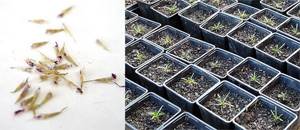
You can cover the containers with plastic wrap, but do not forget to lift the cover from time to time to provide air access to the seeds and get rid of condensation. Watering is recommended moderate, drip, it is done as the soil dries. If all necessary conditions are met, seedlings will appear within 2-3 weeks. After the seedlings acquire the first pair of true leaves, they are planted in the greenhouse.
In the second half of May, when the danger of spring frosts has passed, the seedlings can be planted in open ground. The site is dug up, loosened and weeded in advance, and organic fertilizers are added to the soil. The distance between planting holes can be from 15 to 40 cm, depending on whether you want a continuous flower meadow or several single bushes. Place some sawdust, hay and rotted pine needles at the bottom of the holes. This mixture will provide the plants with useful substances and will not allow moisture to stagnate in the soil.
Place the seedlings in the pits along with a lump of earth. When planting, do not bury the root collar of the plant; under no circumstances should the rosette of leaves become buried. Then fill the hole with soil and tamp down lightly. After planting, water the armeria.
Since the armeria will gain strength throughout the first summer, flowers with the sowing method of propagation will appear only in the second year of the plant’s life.
Sowing in open ground
In regions with harsh winters, armeria is usually sown in the fall so that the seeds undergo natural cold stratification. Please note that the seedlings that hatch in the spring will look like ordinary weeds, so weed the flowerbed very carefully.
For areas with a mild climate, winter sowing is not suitable: the seeds can germinate as early as November and die from the cold. Therefore, armeria is sown here traditionally - in March. The site is prepared in the same way as for seedlings, with one exception: organic matter, which in the first case was placed at the bottom of the planting holes, this time is simply added to the soil before digging.
Sowing is done immediately at a permanent place of growth; the flower does not need further transplants over the next three years.
Rhizome division
Once every 3-4 years, the armeria must be divided, otherwise its roots will be susceptible to numerous fungal diseases, and the above-ground part will grow, stretch out and lose its decorative effect.
The procedure is usually carried out either in early spring (before sap flow begins) or in late autumn (which is most preferable). The bush is dug up and, using a sharp knife, divided into 3-4 equal parts. Make sure that each of the divisions has several growth points and healthy roots. The cut areas are lightly sprinkled with ash, after which the separated bushes are dug in a little. Under no circumstances should you plant them in the old place: over the years, parasites and fungi could have appeared there. The divisions do not require special care: the armeria takes root very quickly and begins to bloom in the same season.
Using flowers in landscape design
Thanks to its dense and bright vegetation, Armeria is widely used to decorate garden plots. It is used to create ridges, rocky compositions, mix-borders, and rock gardens.
The elongated leaves of the crop retain their beauty all year round, thereby forming a continuous green carpet.

In flower beds they are planted next to low-growing representatives of the flora (thyme, bells, phlox). In addition, they create original bouquets from different varieties of armeria.
The inflorescences retain their beautiful appearance even after drying, so they are used to form dry compositions. For these purposes, they are cut off during flowering and hung in the sun with their heads down.

Armeria is undemanding to care, so gardeners, with a minimum amount of effort, can enjoy the healthy appearance of the plant for a long time.
Pest Control
In order for Armeria flowers to delight the gardener with bright colors, it is necessary to protect the plant from pests. Although it is noted that the plant is quite resistant to disease if it grows under normal conditions in acidic soils. If there is insufficient acidity, aphids or spotting may occur.

In advanced cases, pruning of infected shoots will be required. But for prevention and in the initial stages of aphids, you can treat them with insecticides, for example, “Intavir” or “Karbofos” are suitable.
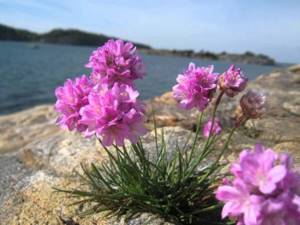
Root rot and spotting often affect the plant in conditions of frequent and prolonged flooding of areas. Treatment with fungicides will help at an early stage.
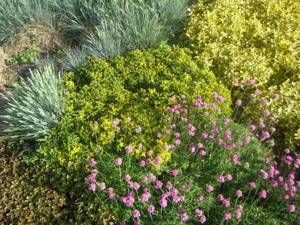
Dense and bright vegetation formed by armeria can decorate a mixborder or ridge. The plant will also look great in stone gardens or rock gardens.

The year-round green carpet blooms with vibrant colors in the summer. You can create a composition from different varieties of armeria or plant it together with bellflower, thyme, and saxifrage.

Types of Armeria
Botanists have recorded about 90 species of Armeria. The most popular is Armeria maritime . It forms thick dark green turf. The height of the plant does not exceed 20 cm. The linear, slightly flattened foliage is colored blue-green. The capitate inflorescences, rising on pubescent peduncles, have a pink-purple hue. Flowering begins in late May and may repeat in September. Popular varieties:
- Vindictive - blooms with large blood-red flowers;
- Louisiana - blooms with pink inflorescences;
- Alba – variety with snow-white inflorescences;
- Solendens Perfecta - blooms miniature light lilac flowers.
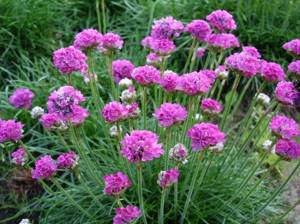
Armeria Alpine. The species lives on mountain slopes and is compact in size. The height of the turf does not exceed 10 cm, and the diameter reaches 30 cm. Many narrow, bright green leaves are preserved even in frosty winter. In early June, a smooth peduncle 30 cm long grows from the center of the rosette. It bears a capitate inflorescence no more than 3 cm in diameter. Small bells in it are painted in light pink tones. Popular varieties:
- Rosea – the turf is covered with many bright pink inflorescences;
- Laucheana – blooms with carmine flowers;
- Alba - with snow-white buds.
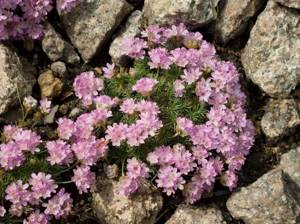
Armeria Alpine
Armeria is turfy. The plant is found in high mountain areas. It forms a dense clump less than 15 cm in height. But the width of the bush can be 20 cm. Narrow dark green foliage is collected in dense rosettes. Above it rise inflorescences on short (about 6 cm) stems. This species blooms in July and pleases with flowers for up to 50 days. The flowering is so profuse that under the many inflorescences it is difficult to distinguish the leaves. The variety has the most capricious character. For normal development, it needs partial shade and shelter for the winter, since severe frosts can destroy this plant. Varieties:
- Biven's Veraiety - white and pink double flowers;
- Brno - double flowers of a lilac hue.
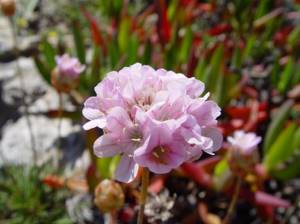
Armeria soddy
